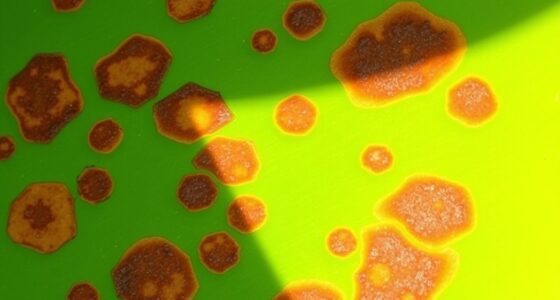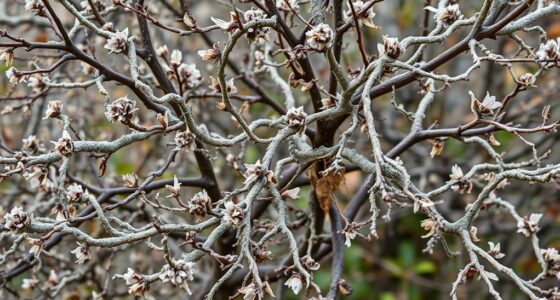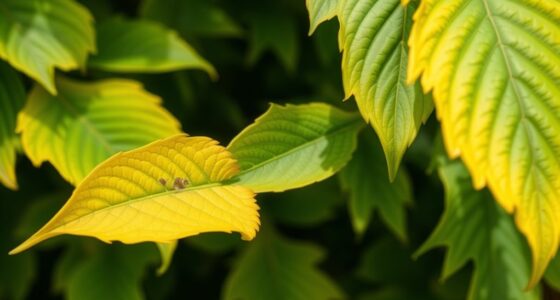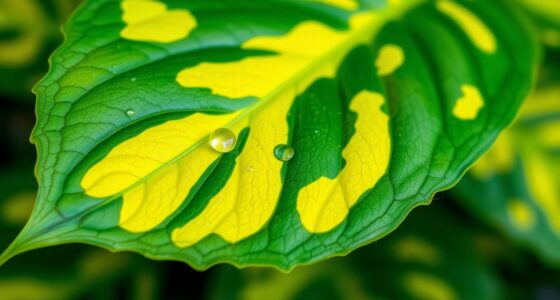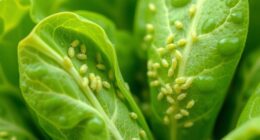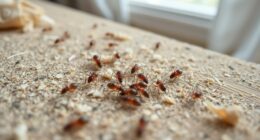If your Loropetalum’s leaves are turning brown, it could be due to several factors. Frost damage, drought stress, or watering issues like overwatering or underwatering often cause browning symptoms. Soil pH imbalance can also limit nutrient uptake, stressing the plant. Proper drainage, moisture management, and adjusting soil pH help prevent leaf browning. To troubleshoot effectively, understanding these causes will guide you toward healthier, greener foliage—keep exploring for detailed solutions.
Key Takeaways
- Brown leaves can result from improper soil pH affecting nutrient uptake, leading to stress and discoloration.
- Frost damage causes blackened, scorched, or wilted leaves, especially during sudden cold snaps.
- Drought stress leads to browning tips, wilting, and leaf curling due to insufficient water availability.
- Overwatering causes root rot and yellowing leaves, while underwatering results in wilting and browning tips.
- Regular soil testing and environmental protection help identify and mitigate causes of leaf browning.
Recognizing Signs of Browning in Loropetalum Leaves
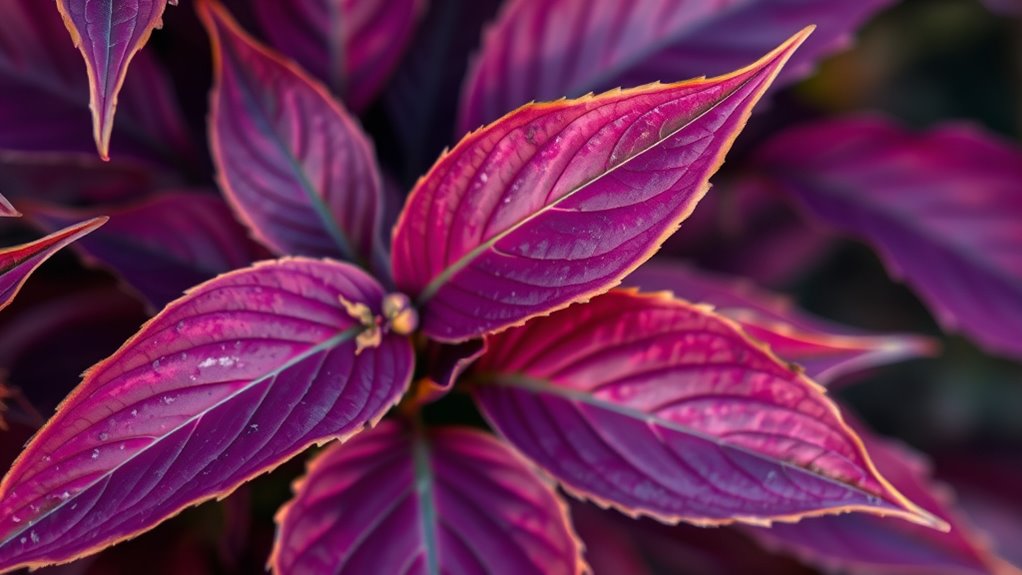
Browning in loropetalum leaves often starts subtly, making it important to pay close attention to early signs. You might notice foliage discoloration, where healthy green turns dull or yellowish, indicating stress. Leaf spotting is another key sign; small dark or brown spots may appear on the leaves, often spreading or enlarging over time. These symptoms can signal issues like disease or environmental stress. Keep an eye out for uneven browning or patches that seem to die back gradually. Early detection is vital to prevent further damage. If you notice these signs, it’s a good idea to inspect your plant closely, noting changes in leaf color and spotting patterns. Recognizing these early indicators helps you address problems before they worsen. Additionally, understanding the plant’s soil conditions can help you determine if pH imbalance or other factors are contributing to the browning, since soil pH plays a crucial role in plant health and stress responses. Checking for proper ventilation and avoiding environmental stressors like drought or frost can also help prevent further browning and promote healthy growth.
Understanding the Role of Soil Ph in Plant Health
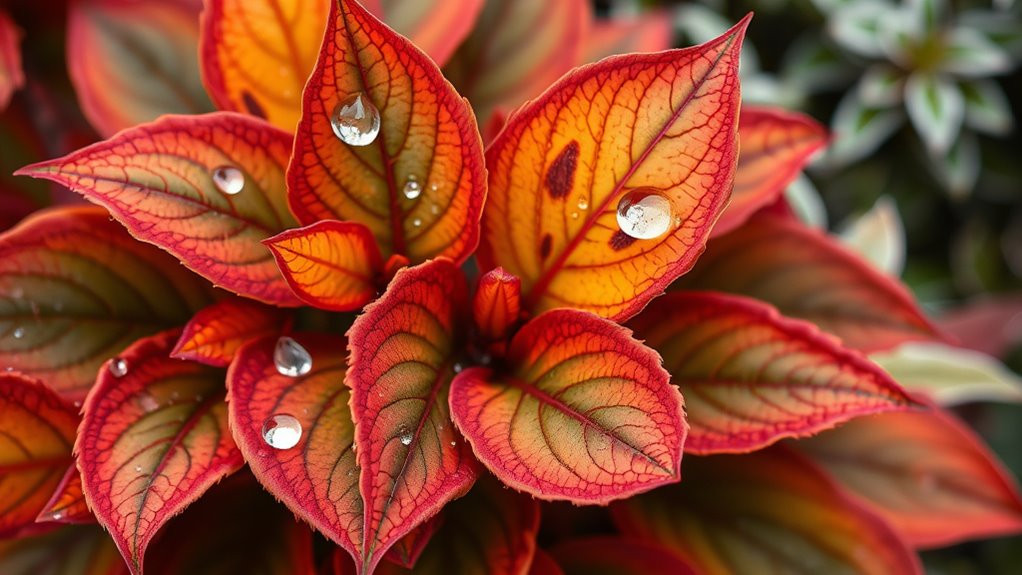
Soil pH directly affects how well your loropetalum absorbs essential nutrients. When the pH is off balance, certain nutrients become less available, causing stress and browning leaves. You can correct pH levels to restore nutrient balance and improve your plant’s health. Monitoring soil pH regularly ensures optimal nutrient absorption and overall plant vitality. Proper soil testing techniques can help identify pH issues early, preventing further plant stress. Understanding soil acidity or alkalinity can also guide you in making appropriate amendments to support healthy growth.
Soil Ph Impact
Understanding the pH level of your soil is essential because it directly influences how well your Loropetalum absorbs nutrients. If the soil is too acidic or alkaline, nutrient uptake becomes limited, leading to browning leaves. Regular pH monitoring helps you identify imbalances early. If your soil’s pH isn’t ideal, you can adjust it with soil amendments like lime to raise pH or sulfur to lower it. Proper adjustment ensures your plant can access essential nutrients, promoting healthier foliage. Keep in mind that soil pH affects nutrient solubility, so maintaining a balanced pH supports overall plant health. By staying vigilant with pH monitoring and using targeted amendments, you can prevent issues related to soil acidity or alkalinity that cause leaf browning.
Nutrient Availability Balance
Maintaining the right balance of nutrients in your soil is crucial for your Loropetalum’s health, and soil pH plays a key role in this process. When soil pH is off, nutrient availability decreases, leading to deficiencies that can cause browning leaves. Proper fertilizer application helps supply essential nutrients, but if the soil pH isn’t right, your plant can’t absorb them effectively. This imbalance can weaken your Loropetalum, making it more vulnerable to pest infestation. Over-fertilizing can also upset nutrient balance, so apply fertilizers carefully based on soil test results. Regularly monitor soil pH and nutrient levels to ensure favorable conditions. When nutrients are available in the right amounts, your plant stays healthy, vibrant, and less prone to issues that lead to browning leaves.
Correcting Ph Levels
Correcting pH levels is essential because an imbalance can prevent your Loropetalum from absorbing nutrients effectively. Start with pH testing to determine if your soil leans too acidic or alkaline. Once you know the pH level, you can adjust it with appropriate soil amendments. For acidic soil, adding lime helps raise the pH, making it more neutral. Conversely, if your soil is too alkaline, incorporating sulfur or peat moss can lower the pH. Regular testing ensures you maintain ideal soil conditions for your plant’s health. Proper pH balance promotes healthy leaf growth and reduces browning. Remember, adjusting soil pH takes time, so be patient and make gradual changes. Maintaining the correct pH level creates a more hospitable environment for your Loropetalum to thrive. Additionally, understanding the impact of soil chemistry can help prevent chemical runoff that might alter soil chemistry and pH over time.
How Frost Affects Loropetalum and Its Foliage
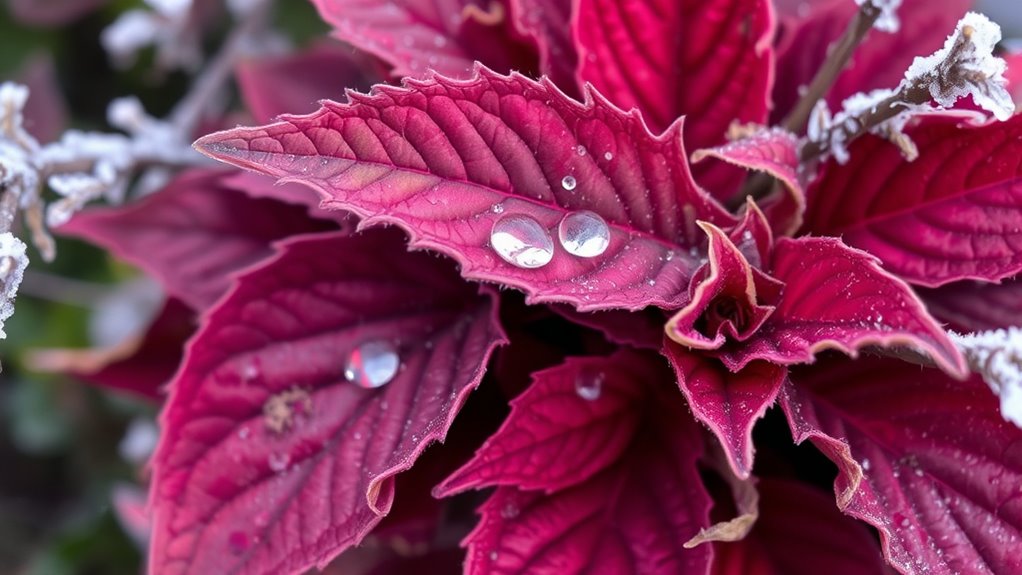
Frost can cause significant damage to Loropetalum foliage, especially when temperatures dip below freezing overnight. Frost damage may appear as blackened or wilted leaves, and leaf scorch is common after a cold snap. To understand its impact, consider the following:
| Frost Damage | Leaf Scorch | Recovery Tips |
|---|---|---|
| Blackened edges | Browning tips | Cover plants or bring inside during cold nights |
| Wilting leaves | Discoloration | Prune affected areas in early spring |
| Cell damage | Leaf curl | Water plants well before frost events |
| Reduced growth | Premature leaf drop | Use frost blankets for protection |
Knowing how frost affects Loropetalum helps you minimize damage and promote healthy regrowth come spring. Additionally, understanding the role of climate factors can aid in better protecting your plants from cold stress, especially considering soil pH levels that influence plant resilience.
The Impact of Drought Stress on Loropetalum
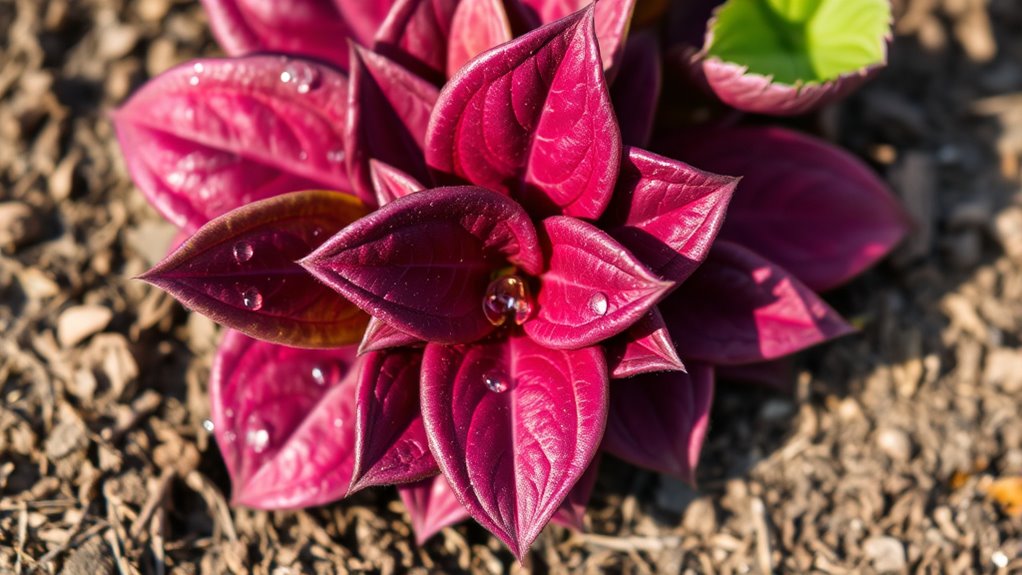
While cold weather can cause visible damage to Loropetalum, drought stress poses an equally serious threat that often goes unnoticed until the plant starts showing signs of decline. When your plant doesn’t receive enough water, it experiences drought stress, leading to leaf browning, wilting, and slowed growth. To prevent this, you need to practice water conservation by deep watering during dry spells, ensuring the soil stays consistently moist but not waterlogged. Drought stress weakens the plant’s ability to transport nutrients and maintain healthy foliage. If you notice browning leaves or drooping, it’s a clear sign your Loropetalum needs more water. Addressing drought stress promptly helps preserve its vibrant color and overall health. Proper watering habits are essential for thriving Loropetalum, especially during dry periods. Additionally, understanding the plant’s soil pH requirements can help optimize its health and resilience against environmental stresses. Maintaining adequate soil moisture levels supports the plant’s natural cellular regeneration processes, which are vital for recovery from drought conditions.
Identifying Overwatering and Underwatering Issues

To keep your Loropetalum healthy, it’s essential to recognize the signs of overwatering and underwatering, as both can cause leaf browning and other issues. Overwatering often leads to yellowing leaves, root rot, and soft, mushy stems. Underwatering, on the other hand, causes leaves to wilt, curl, and turn brown at the edges. To diagnose, check the soil moisture—wet soil indicates overwatering, while dry soil suggests underwatering. Adjust your watering schedule accordingly. Proper pruning techniques can help remove damaged or diseased leaves, improving airflow and reducing pest attraction. Additionally, soil testing can help identify imbalances that contribute to plant stress and leaf browning. Be vigilant about pest control, as pests can exacerbate stress caused by watering issues. Furthermore, understanding your soil pH can help prevent nutrient deficiencies that contribute to leaf browning. Regularly testing the soil’s nutrient levels can aid in maintaining optimal plant health. By addressing watering problems promptly, you can restore your Loropetalum’s health and prevent further leaf browning.
The Importance of Proper Soil Drainage and Mulching
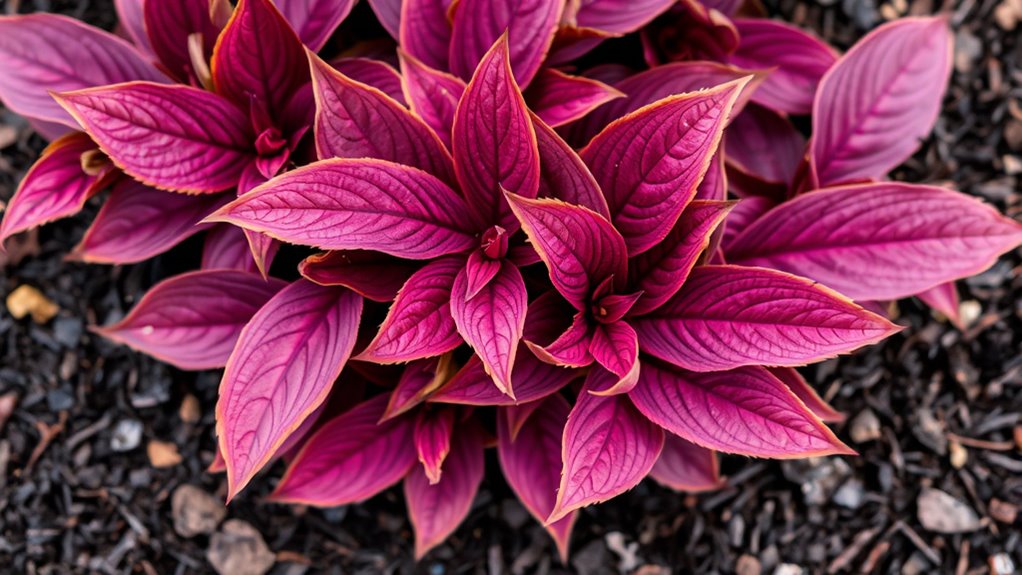
Proper soil drainage is essential for keeping your Loropetalum healthy because it prevents water from pooling around the roots, which can lead to root rot and browning leaves. To improve drainage, consider adding soil amendments like organic matter or sand, which enhance aeration and water flow. Mulching helps regulate soil temperature and retains moisture, but make sure it’s not too thick to hinder drainage. Proper mulching also reduces weed growth and pest problems, supporting overall plant health. Good drainage minimizes the risk of pests that thrive in overly wet conditions, such as fungi and root-eating insects. Regularly checking soil moisture levels ensures you’re maintaining the right balance, preventing both drought stress and overwatering issues that can cause leaf discoloration. Additionally, understanding your soil pH level can help you make informed amendments to optimize plant health. Monitoring soil health regularly is also crucial for maintaining optimal growing conditions for Loropetalum. Incorporating soil testing can provide more precise guidance on necessary adjustments and prevent issues before they become severe.
Adjusting Care Practices to Prevent Leaf Browning

Adjusting your care practices can considerably reduce leaf browning on your Loropetalum. Start by using soil amendments to balance pH levels and improve nutrient availability, which helps the plant stay healthy and resilient. Proper fertilization also encourages lush foliage and prevents stress-related browning. Additionally, implement effective pruning techniques to remove damaged or dead branches, promoting better airflow and light penetration. Regular pruning encourages new growth and reduces the risk of disease, which can cause leaf browning. Be mindful of watering practices, ensuring your plant receives consistent moisture without overwatering. Using portable camping gear such as compact tools and accessories can make garden maintenance more manageable and efficient. Incorporating best small wood stoves into your outdoor gardening setup can provide supplemental warmth during cooler evenings, helping to maintain optimal plant health. By adjusting these care routines—using soil amendments and proper pruning—you can help your Loropetalum stay vibrant and prevent leaf browning caused by environmental stressors.
When to Seek Professional Help for Your Shrubs

If your loropetalum shows persistent browning, sudden leaf loss, or strange behavior, it’s time to call in a professional. These signs can indicate serious issues that simple care adjustments won’t fix. Ignoring them could put your shrub’s health at greater risk.
Persistent Browning Signs
When you notice that your Loropetalum’s leaves remain brown despite regular watering and care, it’s a clear sign that something more serious may be going on. Persistent browning can indicate nutrient deficiencies, often caused by improper fertilizer application, which can weaken the plant and make it more vulnerable. Additionally, a pest infestation might cause ongoing damage, leading to leaf discoloration and decline. If browning persists despite adjusting watering routines, it’s time to seek professional help. An arborist or plant specialist can diagnose underlying issues accurately, whether it’s soil imbalances, pest problems, or other stressors. Addressing these problems early ensures your shrub’s health and prevents further deterioration. Don’t ignore ongoing signs of trouble—professional intervention can save your Loropetalum.
Sudden Leaf Loss
Sudden leaf loss in your Loropetalum can be alarming and often signals a serious problem that requires immediate attention. If you notice rapid shedding of leaves, it might be due to improper fertilizer application or over-fertilizing, which can stress the plant. Additionally, incorrect pruning techniques can damage branches and cause leaves to fall unexpectedly. In such cases, professional help is advisable to assess the plant’s health properly. A trained arborist can recommend the right fertilizer schedule and proper pruning methods to minimize stress. They can also identify underlying issues like pests or disease that may be contributing to the sudden leaf loss. Addressing these problems promptly can help restore your Loropetalum’s vigor and prevent further damage.
Unusual Plant Behavior
Unusual behavior in your Loropetalum or other shrubs often signals underlying issues that require professional assessment. If you notice sudden wilting, persistent browning, or abnormal growth patterns, it could be due to pest infestation or improper pruning techniques. Pests like aphids or scale insects can weaken plants, leading to stress and unusual leaf behavior. Similarly, incorrect pruning may damage the plant’s structure, making it more vulnerable to disease or pest problems. When you see these signs, it’s best to consult a professional arborist or horticulturist. They can accurately diagnose the issue, recommend appropriate treatments, and advise on proper pruning techniques to restore your shrub’s health. Early intervention helps prevent long-term damage and maintains your plant’s significance.
Tips for Revitalizing a Browning Loropetalum

To revive a browning Loropetalum, start by identifying and addressing the underlying cause of the leaf discoloration. Make certain you’re using the right fertilizer choice to promote healthy growth—look for a balanced, slow-release formula rich in nitrogen and micronutrients. Proper fertilization encourages vibrant foliage and overall plant vigor. Additionally, inspect your plant for pests like aphids or spider mites, which can stress the shrub and cause browning. Implement effective pest control methods, such as insecticidal soap or neem oil, to eliminate infestations. Water your Loropetalum consistently, but avoid overwatering. Prune away any severely damaged branches to improve airflow and reduce disease risk. By combining targeted fertilization and pest control, you give your Loropetalum the best chance to recover and regain its lush, healthy appearance.
Frequently Asked Questions
Can Soil Ph Fluctuations Cause Permanent Damage to Loropetalum Leaves?
Yes, soil pH fluctuations can cause permanent damage to your loropetalum leaves. When soil acidity shifts too much, it can lead to nutrient deficiencies, especially of iron and manganese, causing leaves to turn brown or yellow. Over time, these deficiencies can harm the plant’s overall health, making recovery difficult if not addressed promptly. Maintaining stable soil pH helps guarantee your loropetalum stays healthy and vibrant.
How Can I Tell if Frost Damage Is Reversible on My Loropetalum?
Irony strikes—frost damage might seem final, but it often isn’t! To see if your loropetalum can bounce back, check its leaf resiliency. If new growth appears and the damaged leaves don’t turn black or mushy, it’s a good sign of frost recovery. Remember, healthy leaves and fresh shoots indicate your plant’s resilience, so don’t give up hope just yet!
What Are the Signs of Severe Drought Stress in Loropetalum?
You’ll notice severe drought stress in your loropetalum when the leaves turn dull, crispy, or fall prematurely. You might see watering stress signs like wilting or drooping stems. Also, nutrient deficiency can worsen the problem, causing yellowing leaves or stunted growth. To help, make certain of consistent watering and check for proper soil moisture. Addressing these issues promptly keeps your loropetalum healthy and prevents further damage.
Does Soil Compaction Contribute to Leaf Browning in Loropetalum Plants?
Soil compaction can definitely contribute to leaf browning in your loropetalum. It reduces soil aeration, making it harder for roots to access oxygen and nutrients. This stress weakens root health, leading to poor water uptake and nutrient deficiencies. When roots struggle, your plant can show signs of distress like browning leaves. To prevent this, loosen compacted soil and improve aeration around your loropetalum for healthier roots and vibrant foliage.
Are There Specific Fertilizers That Help Prevent Leaf Browning?
When considering fertilizers, you want ones that boost your plant’s importance, promote lush growth, and enhance leaf health. Look for fertilizers with balanced nutrients like nitrogen, phosphorus, and potassium, which support overall plant wellness. Organic options, such as compost or fish emulsion, provide gentle fertilizer benefits that help prevent leaf browning. Regular feeding with these fertilizers encourages healthy, vibrant foliage and keeps your loropetalum looking its best.
Conclusion
So, next time your loropetalum starts browning, don’t rush to blame the weather or soil alone. Sometimes, it’s just your overzealous watering or neglecting to check the pH. Irony hits hard—what seems like a minor issue might be your biggest mistake. With a little attention and care, you can turn those browning leaves into lush, vibrant foliage. After all, who knew fixing a plant’s problems could be so simple yet so unexpectedly tricky?


